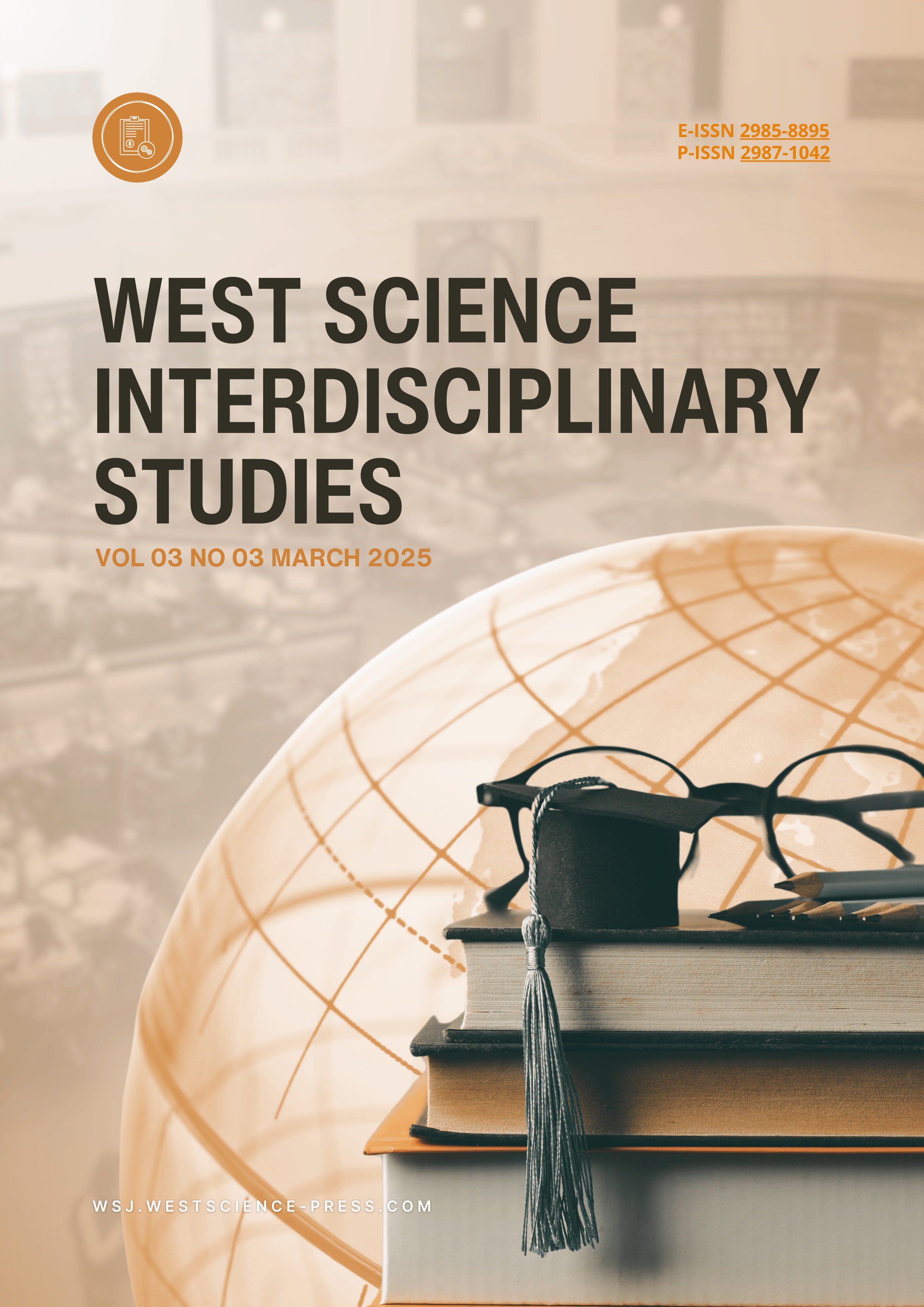Fintech and Traditional Banking: A Bibliometric Study of Financial Innovation
DOI:
https://doi.org/10.58812/wsis.v3i03.1782Keywords:
Fintech, Traditional Banking, Financial Innovation, Bibliometric Analysis, BlockchainAbstract
Financial technology (fintech) has emerged as a transformative force reshaping the financial industry, influencing traditional banking institutions and introducing innovative business models. This study conducts a bibliometric analysis of fintech and traditional banking research using data from Scopus and visualization through VOSviewer. The analysis explores thematic trends, key research contributions, and evolving collaborations within financial innovation. Findings reveal that fintech has transitioned from being a disruptive force to an integral component of the financial ecosystem, fostering partnerships with traditional banks. Key themes include digital banking, blockchain, artificial intelligence, financial inclusion, and regulatory challenges. The study highlights the increasing role of emerging technologies in enhancing financial services while addressing cybersecurity and compliance concerns. Global research collaboration patterns indicate a strong focus on financial inclusion and regulatory frameworks across different economies. This research provides valuable insights into the trajectory of fintech literature and identifies areas for future exploration, particularly in sustainability, AI-driven finance, and central bank digital currencies (CBDCs).
References
[1] V. Komandla and S. P. T. PERUMALLA, “Transforming traditional banking: Strategies, challenges, and the impact of fintech innovations,” Educ. Res., vol. 1, no. 6, pp. 1–9, 2017.
[2] S. Saksonova and I. Kuzmina-Merlino, “Fintech as financial innovation–The possibilities and problems of implementation,” 2017.
[3] I. Romānova and M. Kudinska, “Banking and fintech: A challenge or opportunity?,” in Contemporary issues in finance: Current challenges from across Europe, Emerald Group Publishing Limited, 2016, pp. 21–35.
[4] M. Agarwal, “THE ROLE OF FINTECH IN DISRUPTING TRADITIONAL BANKING MODELS,” UNIFIED VISIONS, vol. 260, 2024.
[5] N. M. Boustani, “Traditional banks and fintech: survival, future and threats,” ICT an Incl. World Ind. 4.0–Towards Smart Enterp., pp. 345–359, 2020.
[6] D. Arnaut and D. Bećirović, “FinTech innovations as disruptor of the traditional financial industry,” in Digital transformation of the financial industry: approaches and applications, Springer, 2023, pp. 233–254.
[7] D. Anand and M. Mantrala, “Responding to disruptive business model innovations: the case of traditional banks facing fintech entrants,” J. Bank. Financ. Technol., vol. 3, pp. 19–31, 2019.
[8] J. Shi and Y. Wang, “Channel Conflict: The Impact of Fintech on Traditional Banking,” J. Humanit. Arts Soc. Sci., vol. 7, no. 7, 2023.
[9] N. Donthu, S. Kumar, D. Mukherjee, N. Pandey, and W. M. Lim, “How to conduct a bibliometric analysis: An overview and guidelines,” J. Bus. Res., vol. 133, pp. 285–296, 2021.
[10] J. Schindler, “FinTech and financial innovation: Drivers and depth,” 2017.
[11] A. Golubev and O. Ryabov, “Transformation of traditional financial companies into FinTech,” in Proceedings of the international scientific conference-digital transformation on manufacturing, infrastructure and service, 2020, pp. 1–7.
[12] Z. Chen, Y. Li, Y. Wu, and J. Luo, “The transition from traditional banking to mobile internet finance: an organizational innovation perspective-a comparative study of Citibank and ICBC,” Financ. Innov., vol. 3, no. 1, p. 12, 2017.
[13] M. Gust, “Traditional banking and disruption fintech. evolutions, causes, typologies,” Rev. Econ. Contemp., vol. 6, no. 1, pp. 57–72, 2021.
[14] H. P. Josyula and F. P. T. Expert, “The role of fintech in shaping the future of banking services,” Int. J. Interdiscip. Organ. Stud., vol. 16, no. 1, pp. 187–201, 2021.
[15] X. Vives, “The impact of FinTech on banking,” Eur. Econ., no. 2, pp. 97–105, 2017.
[16] R. Jarvis and H. Han, “FinTech innovation: Review and future research directions,” Int. J. banking, Financ. Insur. Technol., vol. 1, no. 1, pp. 79–102, 2021.
[17] E. Iluba and J. Phiri, “The FinTech evolution and its effect on traditional banking in Africa—a case of Zambia,” Open J. Bus. Manag., vol. 9, no. 02, p. 838, 2021.
[18] A. Riyanto, I. Primiana, and Y. Azis, “Disruptive technology: the phenomenon of FinTech towards conventional banking in Indonesia,” in IOP Conference Series: Materials Science and Engineering, IOP Publishing, 2018, p. 12104.
[19] L. Nikolic, “Modern financial technologies and traditional banking,” Collect. Pap. Fac. L. Nis, vol. 100, p. 125, 2023.
[20] B. Nkatekho, “The Impact of Fintech Innovations on Traditional Banking Systems,” Int. J. Financ., vol. 9, no. 4, pp. 48–61, 2024.
[21] R. R. Choudhury, M. A. Ferrer, and P. Roy, “Evolution of Fintech and Implications for Traditional Banking and Finance Sector,” Shap. Cutting-Edge Technol. Appl. Digit. Bank. Financ. Serv., p. 147, 2025.
[22] R. Van Loo, “Making innovation more competitive: The case of fintech,” UCLA l. Rev., vol. 65, p. 232, 2018.
[23] N. Pantielieieva, M. Khutorna, O. Lytvynenko, and L. Potapenko, “FinTech, RegTech and traditional financial intermediation: Trends and threats for financial stability,” in Data-Centric Business and Applications: Evolvements in Business Information Processing and Management (Volume 3), Springer, 2020, pp. 1–21.
[24] A. Demirgüç-Kunt and D. Singer, “Financial inclusion and inclusive growth: A review of recent empirical evidence,” World bank policy Res. Work. Pap., no. 8040, 2017.
[25] L. Zavolokina, M. Dolata, and G. Schwabe, “The FinTech phenomenon: antecedents of financial innovation perceived by the popular press,” Financ. Innov., vol. 2, pp. 1–16, 2016.
[26] I. Lee and Y. J. Shin, “Fintech: Ecosystem, business models, investment decisions, and challenges,” Bus. Horiz., vol. 61, no. 1, pp. 35–46, 2018.
[27] J. Jagtiani and C. Lemieux, “Do fintech lenders penetrate areas that are underserved by traditional banks?,” J. Econ. Bus., vol. 100, pp. 43–54, 2018.
[28] D. A. Zetzsche, D. W. Arner, and R. P. Buckley, “Decentralized finance,” J. Financ. Regul., vol. 6, no. 2, pp. 172–203, 2020.
[29] Y. Wang, S. Xiuping, and Q. Zhang, “Can fintech improve the efficiency of commercial banks?—An analysis based on big data,” Res. Int. Bus. Financ., vol. 55, p. 101338, 2021.
[30] F. Allen, X. Gu, and J. Jagtiani, “Fintech, cryptocurrencies, and CBDC: Financial structural transformation in China,” J. Int. Money Financ., vol. 124, p. 102625, 2022.
[31] Y. Li, R. Spigt, and L. Swinkels, “The impact of FinTech start-ups on incumbent retail banks’ share prices,” Financ. Innov., vol. 3, pp. 1–16, 2017.
[32] C. Martínez-Climent, A. Zorio-Grima, and D. Ribeiro-Soriano, “Financial return crowdfunding: literature review and bibliometric analysis,” Int. Entrep. Manag. J., vol. 14, pp. 527–553, 2018.
Downloads
Published
Issue
Section
License
Copyright (c) 2025 Loso Judijanto, Yulistina Yulistina, Wahyuni Sri Astutik, Alfiana Alfiana

This work is licensed under a Creative Commons Attribution-ShareAlike 4.0 International License.
























 Instagram
Instagram 